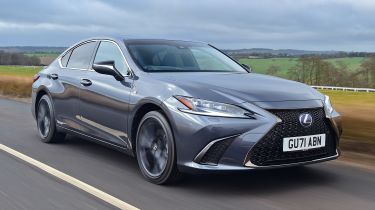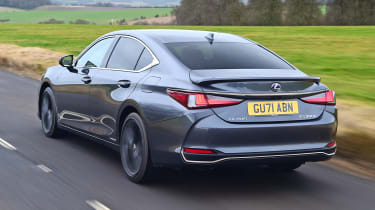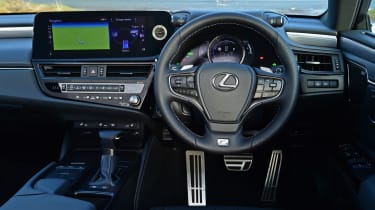New Lexus ES 300h 2022 review
The updates are a welcome addition, but the Lexus ES still lags behind the class leaders where it arguably matters the most - the powertrain

Verdict
The Lexus ES has always been hamstrung in two areas beside its key rivals: a weak powertrain and a poor infotainment system. The introduction of a touchscreen for this facelifted model has gone some way to addressing one of those issues, but the unchanged hybrid system feels anaemic beside a BMW 520d which can be at least as efficient in the real world. It’s a subtle improvement and finance figures are keen, but not enough to see the ES become a credible competitor to the best in the class.
The Lexus ES is often overlooked in the midsize-executive segment. And you can’t really blame buyers for that; when it’s up against such talented competition as the BMW 5 Series, Audi A6 and Mercedes E-Class – not to mention newcomers like the Genesis G80. The Lexus has generally lacked enough plus points, especially when it has always had two key weaknesses.
But now, the ES has had a facelift, and many areas of this sharp saloon have been fettled in a hope to bridge that gap towards the class leaders.
From the outside, there’s little to tell the old and new apart. There’s a new insert for that huge front grille, apart from on the F Sport car that we have here, which still looks the same, and there’s a couple of new wheel designs.
Used - available now
The headlights have also become slimmer, and there’s new “three eye” LED units. Standard on the top spec Takumi and available on the rest of the range through optional upgrade packs, these are claimed to give a much wider field of vision at night. We didn't have old and new to provide a direct comparison, but they do give a great view ahead in the dark.
The most noticeable and most welcome upgrade comes inside, because the 12.3-inch infotainment display now gets touchscreen tech. That alone is a vast improvement, because it means you need never go anywhere near the nasty touchpad input system (which is still there) on the centre console.
But the latest upgrade still feels like something of a halfway house. Having sampled the brilliant system fitted to the latest NX SUV, the graphics and interface of this system still look and feel outdated, and it’s clearly no longer the best that Lexus can do. At least Android Auto and Apple CarPlay are integrated into the setup.
A couple of new colour options and a larger brake pedal aside, there’s not much else new inside. In other words, the ES 300h’s cabin is beautifully finished, but not quite as roomy in the back as most alternatives, especially for headroom.
The revisions to the 300h go beyond the cosmetic though. Changes to the rear wishbone braces have made them more rigid and increased torsional strength, which is claimed to make the car feel more stable – especially during high speed lane changes. A greater range of damping force has been made possible thanks to revised internals for the adaptive units fitted to the F Sport.
The ES was already above average in the class when it comes to its ride and handling compromise, and while the changes aren’t revolutionary, it manages to cover more broken and rippled tarmac without the fidget experienced in a Mercedes E-Class – especially models on larger wheels. It’s fairly sharp through the corners, too, though it still can’t quite match the BMW 5 Series’ mix of unflappable stability and a well-balanced chassis.
Though subtle improvements are clear all across the board, the key letdown remains under the bonnet. The hybrid system consists of a 2.5-litre Atkinson cycle petrol engine, an electric motor and a small battery, with drive sent to the front wheels via an E-CVT gearbox.
The main issue is that compared to turbocharged petrol and diesel engines available in its rivals, it just feels a little lacking in oomph. A 0-62mph time of 8.9 seconds looks fine on paper, but the way it's achieved – accompanied by the drone of the engine working hard as the engine revs don’t match the increase in road speed – makes even getting close to that figure a little unpleasant.
It could be forgiven if the system achieved Prius-like fuel efficiency stats, but the numbers are fairly unremarkable. Our time with the car resulted in mpg figures hovering around the 42mpg mark – not at all bad for a car of this size, but traditional diesel options of some rivals manage to at the very least match that figure, and are quicker doing so, too.
The ES scored a five-star Euro NCAP rating when it was tested back in 2018, but Lexus has improved its collision avoidance tech. The autonomous braking system is now able to detect cyclists in the daytime and pedestrians at night, and it can alert the driver to traffic and people when turning into a junction. Other changes include a revised lane keep system, while the cruise control tech can adjust its speed for approaching corners.
Unlike other left field rivals like the DS 9, the ES is at least right on the mark when it comes to pricing, undercutting the established rivals. Place a £5,000 deposit on an ES 300h F Sport (without the optional Takumi pack), and a three year PCP deal with a 10,000 mile annual limit comes to £482 per month. In contrast, a BMW 520d M Sport, on matching terms, comes to £539 per month. Throw in the likely excellent reliability and high level of service from the Lexus dealer network, and to some that be enough to sway the decision.
There are cheaper options further down the range, too. The standard ES range kicks off from £37,105, though this is for a model without navigation. The most expensive option in the range is the Takumi trim, which when specced with optional digital door mirrors, weighs in at £52,255.
| Model: | Lexus ES 300h F Sport Takumi Pack |
| Price: | £45,360 |
| Engine: | 2.5-litre 4cyl petrol hybrid |
| Power: | 215bhp |
| Torque: | 221/202Nm (petrol/electric) |
| Transmission: | E-CVT auto, front-wheel drive |
| 0-62mph: | 8.9s |
| Top speed: | 112mph |
| Economy/CO2: | 53.2mpg/ 128g/km |
| On sale: | Now |











